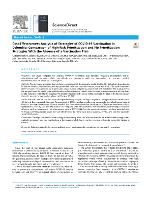Cost-Effectiveness Analysis of Strategies of COVID-19 Vaccination in Colombia: Comparison of High-Risk Prioritization and No Prioritization Strategies With the Absence of a Vaccination Plan
Date
2022-05-26Author
Morales Zamora, Gilberto Andres
Espinosa, Oscar
Puertas, Edwin
Fernández, Juan Carlos
Hernández, José
Zakzuk, Verónica
Cepeda, Magda
Alvis Guzmán, Nelson
Castañeda-Orjuela, Carlos
Paternina, Angel
Metadata
Show full item recordAbstract
Objectives: Our study compares two national COVID-19 vaccination plan strategies—high-risk prioritization and no prioritization—and estimates their cost-effectiveness compared with no vaccination, to generate possible recommendations for future vaccination plans.
Methods: We developed a Markov discrete-time, compartmental, deterministic model stratified by Colombian departments, healthcare workers, comorbidities, and age groups and calibrated to seroprevalence, cases, and deaths. The model simulates
three scenarios: no vaccination, no prioritization of vaccination, and prioritization of high-risk population. The study presents the perspective of the health system of Colombia, including the direct health costs financed by the government and the direct health outcomes related to the infection. We measured symptomatic cases, deaths, and costs for each of the three scenarios from the start of the vaccination rollout to February 20, 2023.
Results: Both for the base-case and across multiple sensitivity analyses, the high-risk prioritization proves to be the most cost effective of the considered strategies. An increment of US$255 million results in an incremental cost-effectiveness ratio of US$3339 per disability-adjusted life-year avoided. The simulations show that prioritization of high-risk population reduces symptomatic cases by 3.4% and deaths by 20.1% compared with no vaccination. The no-prioritization strategy is still cost effective, with an incremental cost-effectiveness ratio of US$5223.66, but the sensitivity analysis the show potential risks
of losing cost-effectiveness under the cost-effectiveness threshold (one gross domestic product per averted disability adjusted life-year).
Conclusions: The high-risk prioritization strategy is consistently more cost-effective than the no-prioritization strategy across multiple scenarios. High-risk prioritization is the recommended strategy in low-resource settings to reduce the burden of disease.
Citar como
Gilberto Morales-Zamora, Oscar Espinosa, Edwin Puertas, Juan Carlos Fernández, José Hernández, Verónica Zakzuk, Magda Cepeda, Nelson Alvis-Gúzman, Carlos Castañeda-Orjuela, Angel Paternina-Caicedo, Cost-Effectiveness Analysis of Strategies of COVID-19 Vaccination in Colombia: Comparison of High-Risk Prioritization and No Prioritization Strategies With the Absence of a Vaccination Plan, Value in Health Regional Issues, Volume 31, 2022, Pages 101-110, ISSN 2212-1099, https://doi.org/10.1016/j.vhri.2022.04.004.Collections
- Productos de investigación [1453]
Compatible para recolección con:

Archivos
The following license files are associated with this item:
Universidad Tecnológica de Bolívar - 2017 Institución de Educación Superior sujeta a inspección y vigilancia por el Ministerio de Educación Nacional. Resolución No 961 del 26 de octubre de 1970 a través de la cual la Gobernación de Bolívar otorga la Personería Jurídica a la Universidad Tecnológica de Bolívar.













